 |
The Floyd Rose Tremolo
| Made
by Schaller in Germany for Kramer, the
Floyd Rose tremolos are some of the best, if not the best tremolo
offered on guitars back in the 80's. Even today, most "metal"
guitarists will agree there is no better locking tremolo on the
market than these trems. Floyd and Kramer worked together to develop
and distribute this unit. In fact, Kramer was the sole distributor
of Floyd Rose trems in the 80's, even ones that were sold individually
(not on guitars). Word has it that Kramer and Floyd had a falling
out in the late 80's because Floyd had agreed to being paid based
on every guitar sold. He eventually sued Kramer in order to retain
his fees, and from what we've heard, he won the suit. The paragraph
below goes into the detail of the story of how he co-developed the
trem with Edward Van Halen and some history. |
|
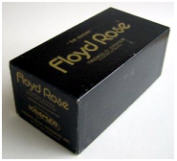 |
 |
Kramer had been in a working relationship with Floyd Rose, a young guitarist/machinist, in the designing of his tremolo unit since 1981 or so. Floyd had actually been working on the design for many years before this, but it wasn¦t until about this time that he had gained the attention of Kramer. Kramer saw a great potential in this new double-locking device, and with the endorsement of Eddie Van Halen playing a guitar with the Floyd, they dropped the optional Rockinger in favor of the new Floyd Rose unit between June of 1982 and January 1983. The Floyd Rose Tremolo is a full (floating¦ tremolo, pivoting on two large screws in the face of the guitar body, that allow upward movement as well as downward. It was best well known for its ability to stay in tune even after the most demanding of abuse. The Floyd Rose tremolo, contrary to popular belief, does not require the cutting of the ball¦ at the end of the string. However, it is held into place by six, vice-like clamping assemblies, one within each of the saddles. You can string the Floyd by placing the ball ends into the Tuner on the headstock as a "stop" and place the other end of the string in the base unit, then wind. Its fine tuners also have much better access since they are on the top of the unit, just past where the hand would rest on the tremolo for the muted effect. |
| |
|
|
| Individual
Floyds from the
Kramer Accessories Catalog |
Magazine
Review right after the Floyd had been developed |
Did
you want a Floyd in the 80's?
Here's what you would have paid |
Floyd
Descriptions and Details
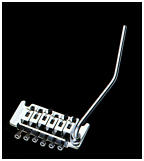 |
Original
Floyd Rose - No Fine Tuners
This original unit was featured on overseas
Focus and Strikers around the 1982-1984 timeframe. The unit has
all the features of the Floyd Rose with fine tuners, however, it
isn't possible to tune the unit when the locknut is in place. See
this picture for an example of Kramer's with this tremolo installed. |
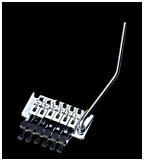 |
Chrome
Original Floyd Rose - With Fine Tuners
This original unit was featured on overseas
Focus guitars around 984-1987 and was used on American Kramer's
as an option on all guitars after 1983. This is probably the most
famous of all the Floyds in that it was used on Edward Van Halen's
5150 and Frankenstrat. Chrome tend to be the most durable of these
Floyds when it comes to rust and pitting. Note: Most Kramers utilize
the screw in trem arm on their Floyds, not the "collared"
trem bar seen on the newer Floyds. The Original Floyd Rose features
the hardened steel fulcrum points. |
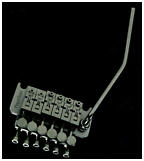 |
Black
Original Floyd Rose - With Fine Tuners
Black units were first used around the
1983 timeframe on the Pacer Carerra and Pacer Imperial. The black
Floyd was also first used on the 1983-1984 early Barettas with the
non-angled headstock. Generally, the black trems hold up pretty
well under abuse. The gold Floyd's (not shown here) are one of the
worst when it comes to pitting and rust. The
black Original Floyd Rose also features the hardened steel fulcrum
points.Some OFR units have
more thin baseplates that other models, and are not very common. |
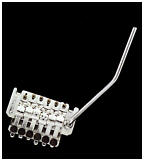 |
The
Floyd Rose II - With Fine Tuners
The II units were used on some of the
later model overseas Strikers, Focus, 100, and 1000 series Kramers
While these trems are not necessarily "crap", they are
not as good as the original since they are cast iron. They rust
much easier, and the fulcrum points are metal inserts as opposed
to being hardened and part of the actual trem metal itself. If you
see a Kramer with one of these, it is NOT an American Series. Additionally,
if you try to use one of these on a guitar that originally had an
OFR on it, you'll have some bad action because the base plate is
thicker than the OFR's. Also
worth of noting, a Floyd Rose III exists
that is actually a non-locking trem made in Asia that Kramer wanted
as an affordable peice. It is slightly different to the Floyd II,
with the III featuring a different base plate (does not appear to
be cast). |
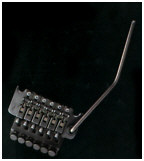 |
The Floyd Rose Pro
The Pro units were installed on later model Kramers. Most notably, they can be seen on Nightswan II's, Pro-Axe guitars, and some Showsters. They differ from the standard units in that the inntonation allen screws are in front of the fine tuners as opposed to the OFR which has them behind the whale tail. Also, the "whale tail" is at an angle versus its OFR relative making the trem a lower profile for players who rest their hands on the unit while playing. The spring block that extends down into the body is shorter as well, keeping the block at the right depth for recessed routed trems. Generally, they work the same, and stay in tune under the most rigorous "whammy" conditions. They cannot be used on traditional OFR "non recessed" routes. |
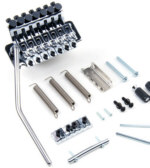 |
The Floyd Rose 7 String - German
The 7 String unit was constructed with the ultra-shredder in mind. It features everything found in the Original Floyd Rose 6 String version, and is constructed in Germany to original specifications for steel hardness. |
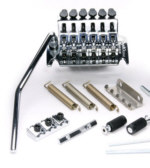 |
The Floyd Rose Special - Korean
The Floyd Rose Special is an Authentic version of a licensed Floyd Rose tremolo system manufactured in Korea exclusively for Floyd Rose. The Floyd Rose Special maintains the construction parameters and features of an Original Floyd Rose, while utilizing zinc alloy saddles in place of steel and a zinc alloy sustain block in place of brass. The design specifications and high quality materials of the Special Series Floyd Rose bridge will hold up to the demands of today's performers. |
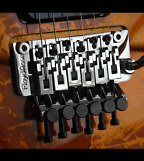 |
The Floyd Rose OEM - Korean
The OEM Floyd unit is near identical to the Floyd Rose Special, but is only found on guitars that are sold with the units installed. These are not sold for purchase individually unless in special circumstances. It features zinc alloy saddles in place of steel and a zinc alloy sustain block in place of brass. |
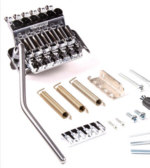 |
The Floyd Rose Speedloader
The Speedloader offers all the versatility of the original Floyd Rose Tremolo with the ease and performance of the SpeedLoader System. The most subtle tremolo or wildest dive-bombing effects can still be executed and return to perfect tuning every time. The SpeedLoader tremolo also features the Floyd Rose TremStopper that enables the player to block the tremolo system with a simple turn of a screw. |
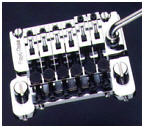 |
The
Les Paul Floyd Rose
The LP units were created by Floyd and
Kramer to be installed on Les Paul guitars with little to no modification.
However, the literature didn't state that the neck would have to
be modified in order to install the locking nut. These are very
rare, and are occasionally seen on ebay for sale. Picture of Les Paul with one installed, click here. |
The History of the Floyd Rose
Picture a freezing Reno, NV, pratice room in the dead of winter, and a
Hendrix-loving, whammy bar-crazed guitarist whose '57 strat just won't
stay in tune. "This has got to stop," he says to himself disgustedly,
and shlumps home determined to solve his problem once and for all. "I
started at the E string" recalls Floyd Rose, inventor of the locking
tremolo system, "and noticed that friction at the nut prevented the
string from returning to pitch. My thought was that the string shouldn't
move at all. So I glued it! This worked, but of course it wouldn't be
practical for very long. But since I was making jewelry at the time and
had lapidary tools, I got some brass and whitled a nut with clamps that
held two strings each. With that, the instrument almost returned to tune,
so I figured the bridge end was causing the rest of the problem."
| Although
tougher to solve, the hitch was the same-how to reduce the friction
caused by metal-to-metal contact? Suspending the bridge in midair
was impossible, so Floyd tried drilling two inverted cones into
the underside of the bridge block and balancing it on two sharpened
pivot points. This was an improvement but adjusting the height of
the strings now became too dificult. The third and most workable
choice was to use a fulcrum system, where the whole bridge assembly
balanced on a single knife-edge and rocked back and forth with an
action similar to a Jazzmaster's "floating" bridge. |
|
| |
Les
Paul Floyd
(rare, no fine tuners) |
Rose drew up a patent design using a Les Paul, modifying it's Bigsby tremolo
with parts cast at the foundry where he worked. For his third prototype,
though, he wanted machined parts and was shocked when a shop wanted $600
for the job. "I was so broke my parents had to pay," he admits
sheepishly. "It worked really well for about 15 minutes, until the
knife-edge went dull. I realized then that I needed to experiment with
tougher materials, so i started studying metallurgy; and, after watching
Mr. $600 work I decided to improve my shop skills too."
| One
of the original Floyd Rose units
(Click on the thumbnail to view
a larger version) |
Floyd
relocated to the Seattle area and found a machinist who generously
donated time on an old bench mill so he could begin production.
"My sales pitch was dropping the bar down until the strings
were like spaghetti, then releasing it and playing a chord. It was
an easy sale!" His second unit went to Randy Hansen, notorious
for his Hendrix tribute concert act, and the third to Edward Van
Halen. "We had a mutual luthier friend-Lynn Ellsworth-who called
Ed and casually asked if he wanted a treolo that stayed perfectly
in tune. 'Uh, yeaaaaah, I think I'd like to see that!" Eddie
replied." See the original tremolo he designed for Eddie (right)
on the VHII Charvel.
The initial systems went for a hefty $350 since Floyd could only
hand-tool six sets of parts at a time; even with his wife Faith
as a bookkeeper and their daughter Alycia racking parts for chrome
plating, he couldn't meet the demand. He decided to try casting
the parts again, but his invention had evolved to where the dies
for maling the casting molds were considered too complicated to
build. Once more Floyd relied on his natural ability and made the
dies himself, which so impressed a skeptical professional tool -and-diemaker
that he offered Floyd a job! But Rose still had to choose between
being a businessman or an inventor. He gladly opted for the latter
by developing an installation kit, and started training others on
how to install his tremolo bar. |
|
| (Click
on the thumbnail to view a larger version) |
Sometime
in 1981-82 Dennis Berardi, president of Kramer guitars, was on his
way to California for a meeting with Guitar Centers which at the
time was a major investor in his company. On the same flight was
one of Van Halen's roadies. When Berardi showed an interest for
meeting Van Halen, the roadie arranged a meeting. EVH and Berardi,
after marveling over the new device, offered Rose an exclusive licensing
aggreement with Kramer guitars. The long-term agreement with Kramer
guitars (and later Fender) had lifted the business burden and Rose
earned several additional patents. In 1990, Rose, still with Kramer
guitars, ended his 8 year association with the company. Apparently,
Floyd's contract granted him a percentage of every GUITAR that went
out the door with his tremolo on it but it seems some were going
out without a guitar attached thus lending a hand in the fall of
the mighty Kramer empire. His other creations during this era include
an electromagnetic sustainer pickup that worked on all six strings.
|
|
Regardless of where Rose's curiousity takes him, he's already earned a
bust in the Guitar Gadgeteer's Hall of Fame for his locking tremolo, a
device which started out as a luxury but had become as essential to modern
playing as a pickup. At the time of this writing, Floyd Rose is still
with Fender and producing some wonderful new gadgets including new single
locking trems.
Floydisms
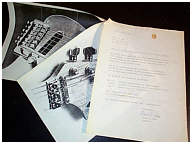 1979
Floyd Literature
1979
Floyd Literature |
The
earliest of Floyd Rose tremolos were, of course, the hand made ones
that were custom ordered. These also have no fine tuners (It's rumored
that Van Halen had his hands in on the idea of the "whale tail"
section holding the fine tuners in later models)and no intonation
adjustment bolts at the front of the saddles but rather, have nuts
on the saddle/string lock down bolts to adjust the intonation giving
the saddles themselves a forward or backward adjustment. These of
course are very uncommon and every once in a great while one will
appear on Ebay.
The earlier production Floyd will not be stamped "Made in W.
Germany" but will rather has a sticker applied to the backside
of the base with this info. Floyd bars of this time were the screw
in variety which required the accomadating collar. Later in the
late 80s, the screw-threaded collar stayed attached to the bar itself. |
Floyd
Rose Today
After acheiving much success in the 80's and 90's with his tremolo,
Floyd has now moved on and is reintroducing a new version of the Floyd
Rose called the Speedloader series. Go to
his website to find out more, and given who its made by, its sure
to be a hit!
| |
|
| Floyd
Rose "the man" today |
The
new Floyd Rose Speedloader |
Vintage Floyd Rose Setup Instructions
Flyer that shipped with American Series
Kramers
Floyd Rose Installation and Setup Instructions - via F*nder
Catalog and box back to F&nder packaged
Floyd Rose Units
Floyd Rose Advertisements
|
Website
and Content © Copyright 2011 Infinite Sky Designs |
|
|



